Tested: 2014 Yamaha YZ250F
A dozen years after its arrival, the bike that revolutionised small-capacity motocross finally gets a major overhaul. With its all-new powerplant, the 2014 YZ250F is clearly faster than its predecessor. But as a package, has it given its rivals something to think about or, better still, to chase?
Yamaha is a case study in contradiction at times. With a design philosophy that’s founded on big-picture innovation, they’ll often introduce ground-breaking technology. But then the Japanese giant is notoriously conservative when it comes to releasing technology to the world. They like to dot their ‘i’s and cross their ‘t’s years before the public gets a sniff of what they’re up to. And that can sometimes create the sense they’ve missed the boat in getting product to market in a timely way. Their revolutionary 250 and 450cc motocross bikes are a perfect example of that. More than a decade ago, these machines changed the course of dirt bike history, and for years, all the other manufacturers could do was play catch-up. But in recent times, Yamaha hasn’t been racing ahead of the pack with technological advances – especially with their YZ250F. Yes, the bike got an alloy frame back in 2006, and the occasional landmark change to chassis, suspension and bodywork since it first arrived in 2001. But the fact remains, this machine has run essentially the same carb-fed, five-valve DOHC powerplant for 12 long years.
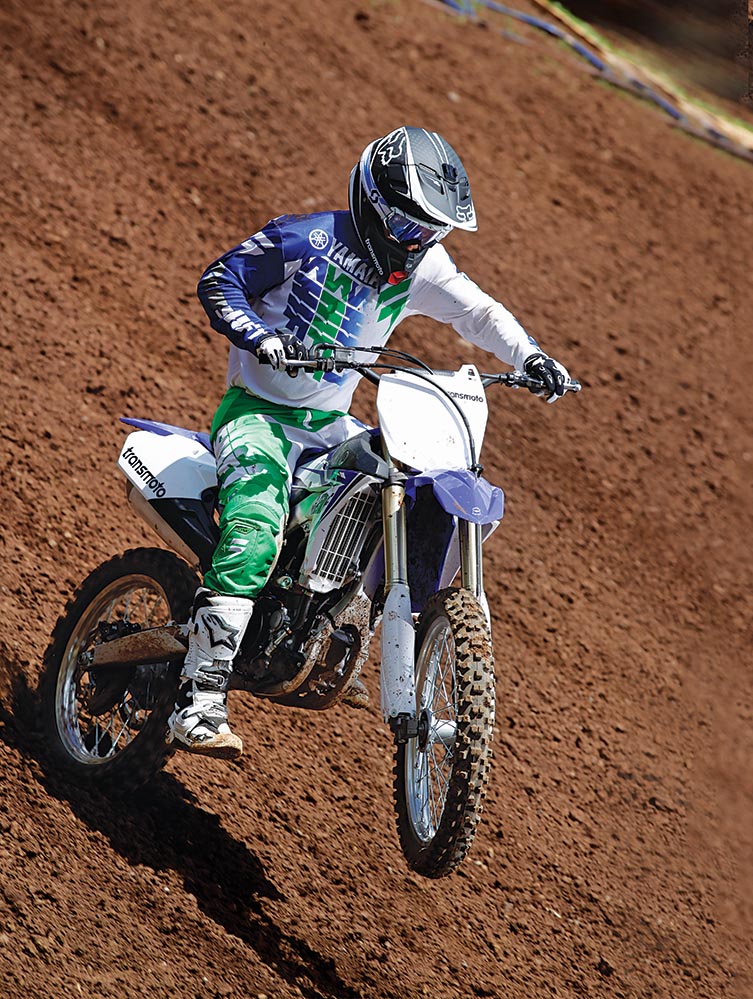
While their rivals have clambered to introduce fuel injection and new-generation forks, Yamaha has stuck with the formula that has brought them so much racing and dealer-floor success. It’s almost as if they haven’t been game to move on from the machine that, in many ways, defined them in the modern era. By 2014, the time had come. Performance mods keep the YZ250F at the front of the pack in racing circles, but the production machine was starting to show its age. There was nothing wrong with its handling or ergos. But the Yamaha’s 250cc powerplant could no longer match the breath of power its rivals were producing. And after 12 years of faithful service, the five-valve engine has finally been replaced by a scaled-down version of the reverse-mounted donk that has powered the YZ450F since 2010. And that’s not the only thing the new 250 shares with its bigger brother. Engine capacity aside, the two machines are now virtually identical. Literally the day before we went to print with this issue, Yamaha Australia staged a launch for the 2014 YZ250F at Toowoomba’s Echo Valley track in Queensland. And, tight as it was ahead of our deadline, we couldn’t pass up the opportunity to throw a leg over this pivotal new model. We wanted to see whether all the hype its American launch generated was justified.
HOW DIFFERENT?
In terms of looks and componentry, the new machine is chalk and cheese different to its predecessor. It’s much easier to mention what hasn’t changed since last year, rather than what has. The front guard and rear wheel carry over from the 2013 bike, but that’s it. So it doesn’t look different just because the engine is reverse-mounted. Aside from the all-new donk, the 250 adapts not only the rolling chassis of the YZ450F, but its bodywork too. It gets the compact new-generation frame, the shorter subframe and a muffler that’s way shorter than its predecessors, thanks to the fact its header now encircles the cylinder. If you’re looking at the bike in isolation, it’s actually very difficult to tell it apart from the 450. The same mass centralisation mantra that drove the upgrades to the 2014 YZ450F have been applied directly to the 250, so the bike’s decals are the only thing that give its identity away.
THE ERGOS
With the air filter relocated to above the engine to suit the new inlet tract and fuel injection (a la the 450), there was always going to be noticeable changes to the look and feel of the 2014 YZ250F’s cockpit. The new tank is a little rounder in the shoulders than last year’s bike, and it does appear to be a tad wider when you look down on the shrouds. But that’s hard to detect when you’re standing or sitting on the bike because the dimensions that count – the contact points with your legs and knees – remain very similar. It’s not the slimmest 250F on the market, but it’s not fat either. There’s something about that ‘missing’ fuel cap that makes the bike appear wider than it actually is – like a gut that looks bigger without a belly button! Like most Yamaha motocross bikes in the past decade, the new 250’s ergos are remarkable for being unremarkable. And you’ve got to say that, given all the changes going on beneath the seat on the 2014 bike, the impact on the peg/seat/handlebar triangle has been negligible. It’s a homely cockpit with comfortable seat foam. If anything, the seat is a little flatter than last year’s, and with no fuel cap to get in the way of your goolies, its super-smooth junction with the ‘tank’ allows you to get forward in the seat easier. Like the 450, the 250’s grips are hard and the rubber-mounted bars will be met with mixed reactions. And blokes used to Euro brands might miss the OTF adjuster on the brake and clutch levers. But, those small details aside, there’s little to complain about.

THE ENGINE
The five-valve, carb-fed engine used in the YZ250F for more than a decade has finally given way to an all-new DOHC, four-valve, fuel-injected powerplant with the same reverse-oriented cylinder, offset cylinder and Keihin EFI system as the YZ450F. It’s claimed to generate an extra 6hp, particularly through the mid-range and top-end. The new engine uses the same bore and stroke (77 x 53.6mm) and compression ratio (13.5: 1) as its five-valve predecessor, but that’s where the similarities end. The new specimen comes with completely redesigned inlet and exhaust ports, cam profiles, ECU, carburized crankshaft, transmission and clutch, and a new two-ring forged piston. Like the 450, the 250 uses an exhaust header that encircles the cylinder, a wet-sump lubrication system, and a redesigned transmission and shift mechanism. Last year’s 39mm Keihin carb is replaced by Keihin EFI system that reverse-feeds the engine via a much straighter inlet tract. Both 250 and 450 run the same 44mm throttle body, but the 250 gets a 10-hole injector while the 450’s injector has 12 holes.
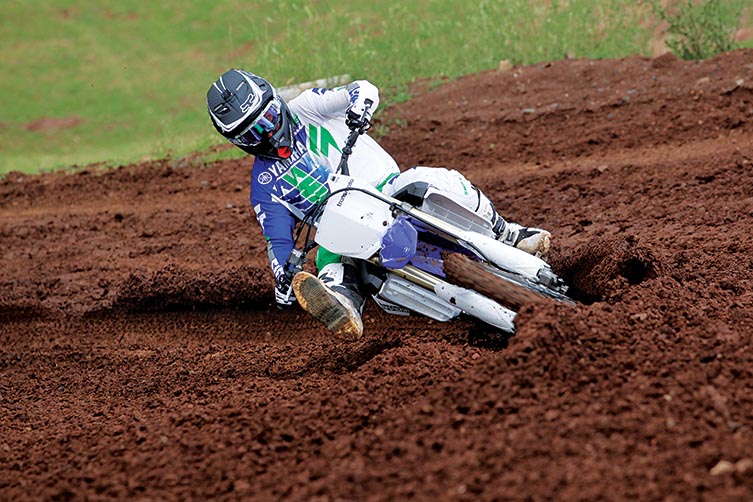
TALK ABOUT POWER
You can carry on as much as you like about steering, handling and suspension, but with small-bore motocross bikes, power always takes on a relatively greater importance. And power is exactly what much of Yamaha’s pre-release marketing guff about the new 250F focused its attention on. As we soon discovered at the launch, that was with good reason. This new four-valve, fuelinjected donk leaves its predecessor for dead. It’s a truly impressive mill that represents a quantum leap in power, and one that actually changes the way you ride the machine. For starters, it fires into life much better than the carb-fed 2013 machine and idles in a much smoother and more refined way. With a damn big hole in the muffler’s end-cap, the exhaust note is throatier, and just sitting there in neutral, you can notice how much quicker its revs build when you crack the throttle. Once you ride the thing, those differences are exaggerated. Compared with the 2013 engine, the power comes on earlier and with more instantaneous response to throttle inputs. That creates a smoother transition into a meatier, torquier mid-range. And up top, this engine puts the 2013 bike – whose engine has long been renowned for its top-end performance – to shame. The EFI engine pulls hard all the way to it 13,500rpm rev limiter. So it’s broader, stronger and more responsive with crisper fuelling at all throttle settings and that added get-out-of-trouble snap that YZ250F pilots have always craved. The added bottom-end makes it a more forgiving, usable donk for Clubman riders.
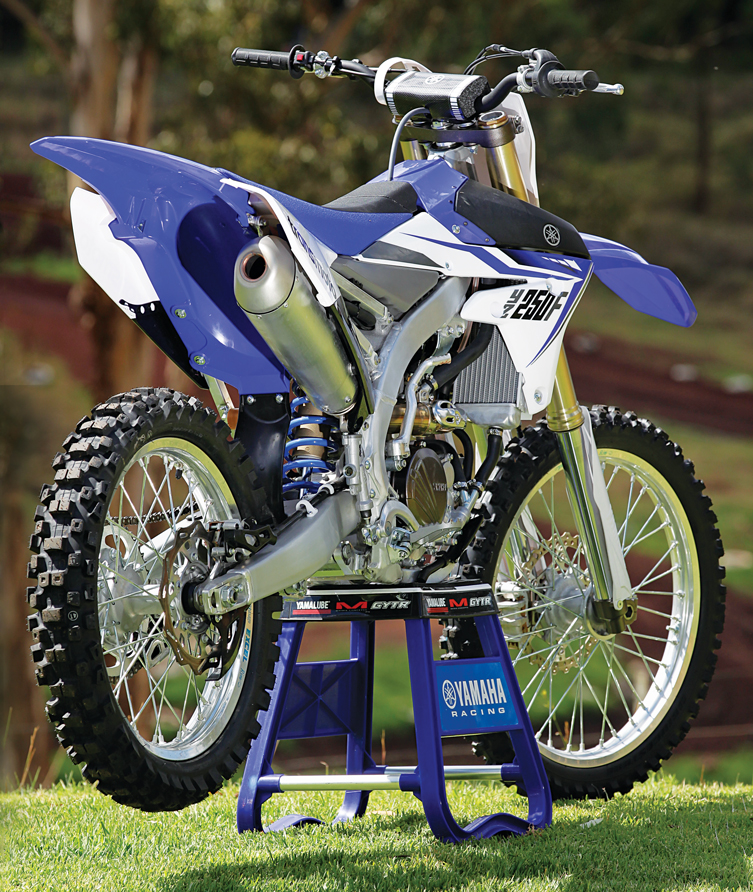
It makes life easier when you need to clear a jump from an inside line, and less likely to get caught in the wrong gear in sandy conditions. The extra top-end poke will have racers lining up to ride the thing, but the point is, you no longer have ride it like a maniacal rev-limiter jockey to get it rockin’. You can get way with using fewer revs to deliver even better drive. That’s a win-win. So there’s not a lot to complain about with this new engine. Or is there? Well, it does have an audible induction noise. We don’t mind that, but some blokes did on the previous YZ450F. And we did spend some time mucking around with the gearing, as we often found ourselves caught between second and third gears around the undulating Echo Valley test track. The taller 13/50 final gearing combo (compared with last year’s 13/51) didn’t quite carry third gear as well as we’d have liked though some corners, but the 51-tooth rear didn’t make much difference. So we tested a 49-tooth rear to extend second gear’s usable range through turns, and found that that saved us several gear changes per lap. It wasn’t until we tested the 2014 model back-to-back with the 2013 that we realised the gearing issues had more to do with the test track’s 700-metre altitude than any deficiencies with the new bike’s power or gearing. Mechanics will all tell you that 250Fs always feel sluggish around Echo Valley, especially when the clay is tacky and offers superb traction – as it was during the launch.
THE RIDE
We’re yet to put the 2014 YZ250F onto the scales, but Yamaha claims the new bike is 1-2kg heavier than its predecessor – due mainly to the addition of the fuel injection. But when you ride the thing, you’d swear it was 4-5kg lighter. The mass centralisation design mantra that Yamaha engineers have lived by in recent years might sound like marketing spin, but it actually works. The 2014 bike feels so much lighter to flick from side to side through chicane-style corners, and in the air, it makes an average rider feel like it’s whip-time. The new bike requires noticeably less rider input into the pegs and bars to change lines mid-corner or to tip into a rut at the last minute. Once settled into a corner, the chassis has a poised and stable temperament. It might run an identical rolling chassis to its 450cc sibling, but with less power and weight, the 250’s chassis feels incredibly agile. And with so much confidence-inspiring feedback from the front wheel, it makes you want to throw the bike at bumps, turns and jump faces. Unlike at the recent launch for the YZ450F – where everybody seemed to be experimenting with the fork legs’ position in the triple clamps – we didn’t see a T-bar go near a triple clamp all day at the 250’s launch. And that’s despite the fact that the test track has big, fast downhill braking areas that quickly reveal any inherent chassis instability. It’s interesting that Yamaha has given the 2014 YZ250F firmer spring rates at both ends – just as they did with their 2014 450.
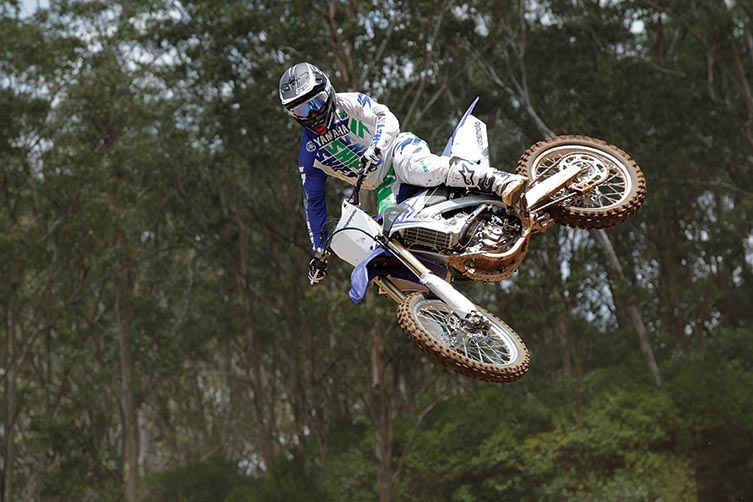
But they’ve coupled the firmer springs with substantially softer compression damping for both fork and shock, and this has created a noticeably plusher ride over small bumps. Yami technicians tell us that the fork’s compression stack now has four crossover shims compared with last year’s one – which, in itself, helps explain how they achieved the more compliant ride in the first part of the stroke. For the average rider up to 85kg, there’s plenty of progression in the damping at both ends and decent bottoming resistance. Plus the shock seems to work much better than the 450’s over small, choppy acceleration bumps. But you do get the feeling that this year’s suspension is a little more focused on the average rider than the Pro racer. For fast riders, the Kayaba fork and shock are both inclined to push through their stroke on bigger hits. And by the end of the launch, a greater majority of the faster test pilots had the fork’s compression clickers wound in to just 2-3 clicks out. In other words, they were all using the clicker adjustment to help hold the fork up in its stroke. This in turn made the rear wheel less inclined to kick you in the arse under brakes. Admittedly, Echo Valley’s steep downhills and big braking bumps do highlight any shortcomings in the fork’s mid-stroke progression, but the launch group’s clicker preferences painted a very clear picture. Similarly, with the shock using all of its travel on jump upramps, we ended up dialling in more high-speed compression. Instead of the 1.5-2 turns out conventionally used, the 2014 YZ250F works better at just half a turn out. It’s less ‘poppy’ off jumps that way.
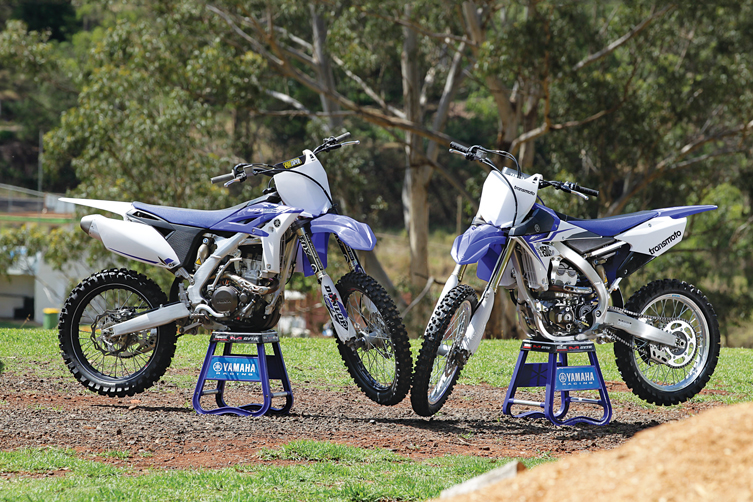
TRADE-UP TIME?
Without a doubt. Manufacturers always talk a big game with their annual upgrades, but there’s no denying the quantum leap the 2014 YZ250 makes over its predecessor.The new bike not only comes with more power and agility; it’s also a more versatile machine for riders of varying weights and abilities, and gentler on the body to ride for extended periods. Unlike last year, when the YZ250F was $500 to $1000 cheaper than its rivals, the blue bike is back on RRP par with the other manufacturers. And so is the performance of the product.
Related Content

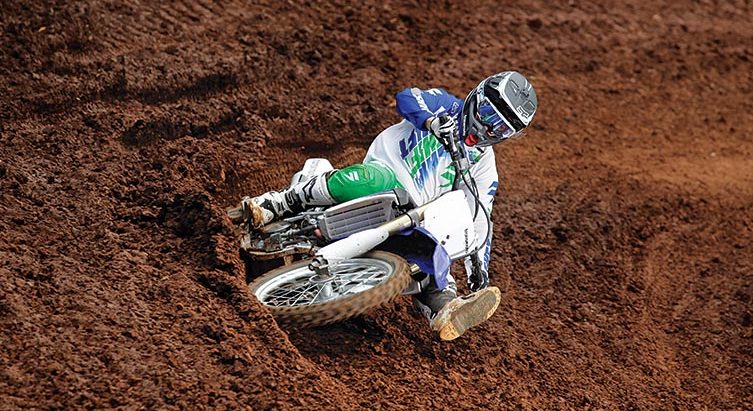


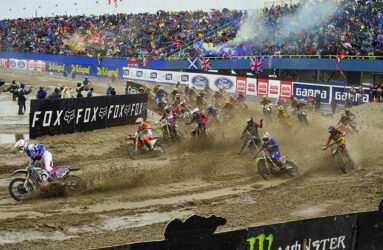
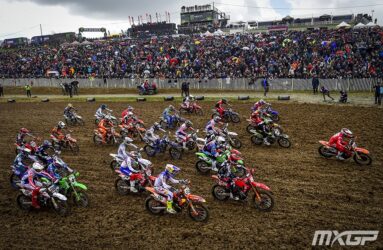


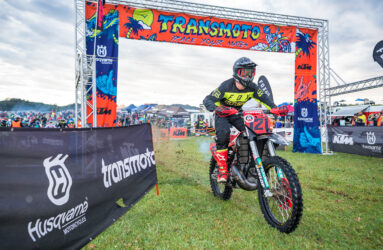


Be the first to comment...